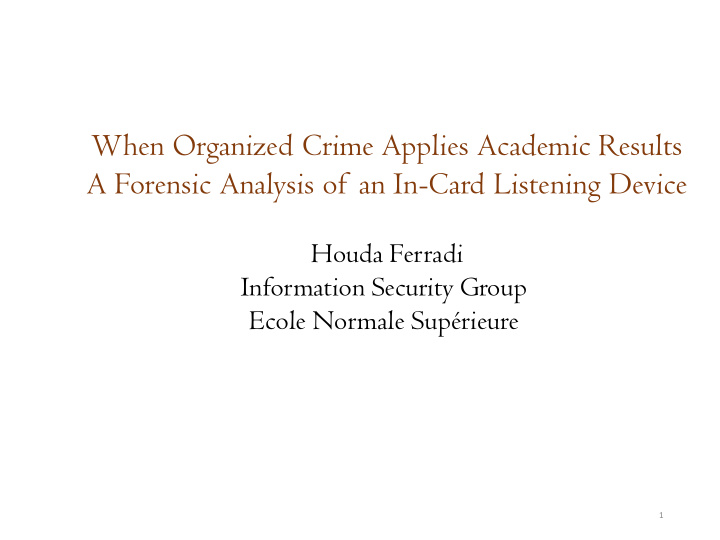



When Organized Crime Applies Academic Results A Forensic Analysis of an In-Card Listening Device Houda Ferradi Information Security Group Ecole Normale Supérieure 1
Goal of This Presentation Illustrate to what length white collar criminals can go to hack embedded electronic devices. To date, the following is the most sophisticated smart card fraud encountered in the field. Goal Goal: raise aise awar aren enes ess to to the the le level el of of res esistan istance ce that that IoT oT devices ices must st have to to resist ist real al attac acks in in the field ld. 2
Context A forensic assignments. 3
Context In May ay 2011 11: T he French’s bankers Economic Interest Group (GIE Cartes Bancaires) noted that a dozen EMV cards, stolen in France a few months before, were being used in Belgium. The net loss caused by this fraud is estimated to stand below 600,000€, stolen over 7,000 transactions using 40 modi fi ed cards. A forensic investigation was hence ordered by Justice 4
The Judicial Seizure 5
The Judicial Seizure What appears as an ISO/IEC 7816 smart card. The plastic body indicates that this is a VISA card issued by Caisse d’Épargne (a French bank). Embossed details are: • PAN5= 4978***********89; • expiry date in 2013; • and a cardholder name, hereafter abridged as P .S. • The forgery’s backside shows a normally looking CVV . PAN corresponds to a Caisse d’Épargne VISA card. PAN=Permanent Account Number (partially anonymized here). CVV=CardVerification Value. 6
Visual Inspection The backside is deformed around the chip area. Such a deformation is typically caused by heating. Heating (around 80°C) allows melting the potting glue to detach the card module. 7
Visual Inspection The module looks unusual in two ways: 1) it is engraved with the inscription “FUN” ; 2) glue traces (in red) clearly show that a foreign module was implanted to replace the **89 card’s original chip 8
FUNCards 9
FUNCard’s Inner Schematics 10
Side-views show that forgery is somewhat thicker than a standard card (0.83mm). Extra thickness varies from 0.4 to 0.7mm suggesting the existence of more components under the card module, besides the FUNcard. 11
FUNCard Under X-Ray External memory (AT24C64) µ-controller (AT90S85515A) Connection wires Connection grid 12
FunCard vs. Forgery under X-Ray 13
Forgery vs. FunCard Stolen card module Connection wires added by fraudster Welding points added by the fraudster 14
Pseudo-Color Analysis Definition: Materials may have the same color in the visible region of the EM spectrum and thus be indistinguishable to the Human eye. However, these materials may have different properties in other EM spectrum parts. The reflectance or transmittance spectra of these materials may be similar in the visible region, but differ in in other her regio ions ns. Pseudo-coloring uses information included in the near-infrared region (NIR) i.e. 800-1000nm to discriminate materials beyond the visible region. 15
Pseudo-Color Analysis 16
Pseudo-Color Analysis Stolen chip 17
Forgery Structure Suggested so Far 18
Forgery Structure Suggested so Far Stolen card speaks to reader but instead of the reader the communication is intercepted by the fun card 19
Forgery Structure Suggested so Far What the stolen card says goes into the FUNcard 20
Forgery Structure Suggested so Far FUNCard talks to the reader 21
Electronic Analysis Attempt It is possible to read-back FunCard code if the card is not locked. Attempted read-back failed. Device locked. Anti-forensic protection by fraudster. 22
Magnetic Stripe Analysis The magnetic stripe was read and decoded. ISO1 and ISO2 tracks perfectly agree with embossed data. ISO3 is empty, as is usual for European cards. 23
Electronic Information Query Data exchanges between the forgery and the PoS were monitored. • The forgery responded with the following information: • PAN = 4561**********79; • expiry date in 2011; • cardholder name henceforth referred to as H.D. All this information is in blatant contradiction with data embossed on the card. The forgery is hence a combination of two genuine cards 24
Flashback 2010 25
Flashback 2010 26
The problem is here! 27
Flashback 2010 28
Flashback 2010 29
Flashback 2010 30
Modus Operandi Hypothesis 31
Problem with Hypothesis! no visible signal activity here! 32
Back to X-Ray: Solution to Riddle! no visible signal activity here! 33
Anti-Forensic Protection by Fraudster 34
Using Power Consumption Analysis 35
Color Code: FunCard PoS Stolen Card FunCard Stolen Card FunCard PoS FunCard PoS sends the ISO command 00 A4 04 00 07 Command echoed to the stolen card by the FunCard Stolen card sends the procedure byte A4 to the FunCard FunCard retransmits the procedure byte to the PoS PoS sends data to FunCard FunCard echoes data to stolen card Stolen card sends SW to FunCard FunCard transmits SW to PoS 36
Power Consuption During GetData Confirms the modus operandi 37
VerifyPIN Power Trace Analysis Power trace of the forgery during VerifyPIN command. Note the absence of retransmission on the power trace before the sending of the SW 38
Having Finished All Experiments We can ask the judge’s authorization to perform invasive analysis. Authorization granted. 39
Invasive Analysis Connection grid Stolen card module (outlined in blue) Stolen card’s chip FunCard module Welding of connection wires 40
Invasive Analysis FunCard module Genuine stolen card Welded wire 41
Original EMV Chip Clipped by Fraudster Cut-out pattern over laid 42
Wiring Diagram of the Forgery 43
Economical Damage Cost of device replacement in the field Cost of fraud (stolen money) Damage to reputation plus: Forensic analysis cost. Here: 3 months of full time work. 44
In Conclusion Attackers of modern embedded IoT devices • Use advanced tools • Are very skilled engineers • Are well aware of academic publications • Use s/w and h/w anti-forensic countermeasures If you do not design your IoT device with that in mind and if stakes are high enough, the devi vice ce will be brok oken. 45
Recommend
More recommend